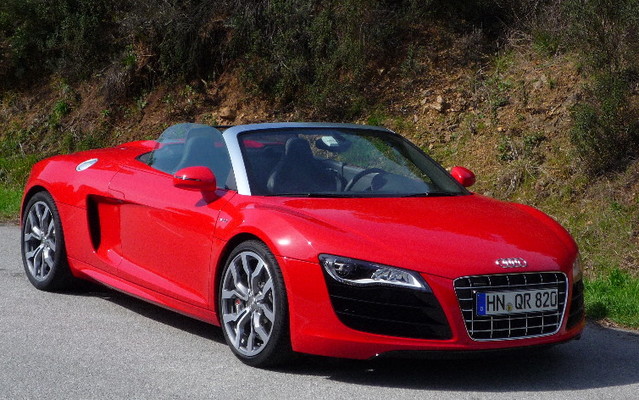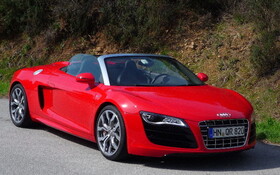The 2011 Audi R8 Spyder, a multi-sensory experience
As soon as Audi unveiled the first version of the R8 Sports Coupe, compliments flooded in for the vehicle, which was even named Canadian Car of the Year by AJAC. In fact, I have yet to meet someone who thinks this car is unattractive or undesirable. Then the V10 version came along. Just as elegant, but with better and sportier performances, we thought Audi had covered all its bases with this model – but that’s because we didn’t know Audi well enough. At the September 2009 Frankfurt Auto Show, the manufacturer from Ingolstadt made a splash with the cabriolet version.
As a general rule, when a coupe is made into a convertible, something gets lost in terms of looks and dynamics. Indeed, the amputation has a negative impact on the car’s silhouette, and the body reinforcements needed for adequate rigidity make the vehicle heavier and throw it off balance. Well, that’s what generally happens. But with an Audi, you can always expect a little better.
Test driving this Audi was nothing short of a multi-sensory experience. A treat for the eyes and ears, and with delicious tactile sensations, it was positively exhilarating to drive.
At the risk of repeating myself, this Audi featuring a central engine lost none of its elegance when it was made into a cabrio. Actually, it turned more heads than any other vehicle I’ve driven to date. We drove this cabriolet in Antibes, South of France. You should have seen the looks we received – some people even snapped photos of it on their cell phones. And though this beautiful German machine is more attractive with its soft top tucked away, it actually doesn’t look bad with the roof up, which is fairly rare for this type of car. As for the roof, it deploys in less than 20 seconds and has great soundproofing, as we’ve come to expect from Audi. The roof can be put up or taken down while you drive, even up to 50 km/hr! Admit it, you’ll at least want to try it once. This feature is particularly useful if you find yourself in a sudden downpour. No need to pull over; just slow to a little less than 50 km/hr and presto! Granted, visibility is not as good once the roof is up, but it’s no worse than other vehicles in its category. One thing worth pointing out is that the rear window with integrated defrost is separate from the roof – just press a button to put it up or down. This makes it possible to improve interior ventilation quickly and easily.
Test driving this Audi was a tactile experience in more ways than one. First off, the interior features high-quality leather, and the fit and finish is as good, if not better than, the luxurious A8 sedan. It’s certainly a far cry from the dreadful finish we used to see on Italian sports cars. While the Italians have come a long way in this area, I’m willing to bet that the R8 Spyder is still the reference in this department. In addition, several machined aluminium controls and buttons are pleasant to the touch and add to this vehicle’s sensorial superiority. But the most remarkable feature in terms of tactile satisfaction is the shifter. It’s made entirely of aluminium, and is topped with a machined aluminium knob. It glides through an aluminium grid, which means it is practically impossible to make a mistake when changing gears.
Another tactile sensation awaits you with the flat-bottom Audi Sport steering wheel. Wrapped in leather, it has just two oversized spokes (one at 3 o’clock and the other at 9 o’clock) so that you can get a good grip on it. Its height and depth are adjustable, though I found its vertical range rather limited. Another detail is the superb lateral support from the seats, even at shoulder height. On some models, you can adjust the width of the seat and backrest to ensure optimal lateral support. However, since the leg room is not generous, I had to find a compromise between the incline of the backrest and the position of the seat itself. A subtle touch of class is found on the seatbelt: three buttons, each the size of a pea, control the sound quality of the hands-free telephone when you’re cruising with the roof down.
A symphony in V10
The V10 engine that powers the Spyder’s four wheels not only packs a punch with its 525 horses, but the way it sounds is... heavenly. Especially when coupled with the manual gearbox, as it allows the sound to range from guttural to high-pitched to nervous, depending on which gear you’re in. You’ll be blown away by the music you can make with this engine. I know some people may find this kind of thing silly or childish, but I’m not going to apologize for what I’m passionate about. Interestingly, when paired with an automatic transmission, the engine’s sounds are still nice, but a lot less exciting. You can get some of the same sounds as with the version with a manual transmission, but you either have to use the steering-wheel-mounted paddle shifters or move the shifter up and down. Leaving the shifter strictly in automatic won’t give you the same effect. Worth mentioning: this automatic gearbox comes with a Sport mode that delays shifting to optimize performances and accelerations. That said, while this gearbox offers decent performance overall, as a single-clutch it simply doesn’t have the same panache as the DSG gearbox offered in several other Audi models. We were assured, however, that Audi engineers are fine-tuning a DSG that can handle the V10’s high level of torque.
The suspension with magnetic ride control can also be put in Sport mode for better road handling. However, this results in a marked reduction in comfort. And we did our test drive in the South of France, where the roads are in much better shape than many parts of Canada
As you might expect, the sportiest Audi comes with Quattro AWD, which is still the best in its category. This highly sophisticated technology posted an average of 14 L/100 km after two days covering the back roads of Côte d’Azur. This included the traffic-bound areas in and around Nice and Antibes, as well as high speeds on the A8 highway. Not to mention the windy country roads that definitely put the mechanics to work. This fuel consumption is actually pretty reasonable, given the power of the engine, the width of the tires, and the AWD, not to mention our more-aggressive-than-average driving style.
Like it’s on rails
Losing its roof did nothing to dampen the R8’s performances or road handling. Sure, the addition of a removable roof, its mechanism and the necessary reinforcements (to ensure the rigidity of the body) made the car heavier. And yet, the Spyder weighs just over 100kg more than the coupes, which is nonetheless pretty exceptional. This can be at least partly attributed to the fact that the body is made entirely of aluminium and tips the scales at just 216 kg.
When this car was presented to the press, I had the chance to take it out for a few laps on the back roads near Cannes, Fréjus, Saint Raphaël and Antibes. This route offered maximum diversity, though we did have to spend several minutes in Côte d’Azur’s unpredictable traffic before we were able to hop on the A8 and head toward the back country, with its mountains and endless curves.
The first run was done in a manual which was distinctly sportier since you have better control over the engine’s power. The clutch pedal isn’t too firm and changing gears is easy. Plus, the six gears are divided into three groups. The first two are for rapid accelerations; gears three and four are for city driving; and five and six are for the highway. The flexibility of the engine and its generous torque at low revs (for an engine that likes high revs) mean that you don’t have to change gears all that often. Driving down side rural at about 50 km/hr, I left it in fourth gear, and neither the engine nor the performances suffered.
On them mountain part of our itinerary, it was tight curve after tight curve, but the vehicle proved to be excessively neutral to them. We know that the Quattro AWD can produce some under-steering on most Audi models, but the fact that the R8 Spyder Cabriolet has a central engine means you get near perfect balance. Add to that precise steering and great assistance, and you get a very fun vehicle to drive! However, I struggled to find just the right amount of pressure to put on the brakes, especially when they were cold. They’re powerful, and one of the models’ brakes had a ceramic coating, which made their braking power absolutely mind-blowing. For that extra braking power, you pay an additional €9,400 in Europe. Youch!
The next version I drove featured a G Tronic gearbox, which also has six gears. You can leave the lever in the "A" position and the gearbox takes care of everything. Or you can shift gears moving the shifter forward and back. Or you can use the paddles on the steering wheel. Gear shifts are very fast, and the transmission handles the blip when in reverse to harmonize the speed of the engine. This transmission was particularly useful in the Antibes traffic, but overall it’s really not as fun to drive as the manual. In sum, this Audi is spectacular both aesthetically and mechanically. It did not disappoint. Quite the opposite ! Sure, it may be less precise than the coupe with the V10, but it’s elegant, easy to drive and its performances are outstanding. Road handling is exceptional, and if you ever push the vehicle beyond its very, very high limits, the electronic driver assist systems can get you out of a pickle.
This gorgeous German is out to rival Ferrari and Lamborghini, and it does so with fantastic attributes. Plus, at under $200,000, it joins the Mercedes-Benz SLS as one of two incredible deals in its category. That is, if you can call cars in that price range "deals."












